Salinity Management Guide
Problems involving trees, shrubs, and ground covers
Plant damage resulting from salt-affected soils and saline waters
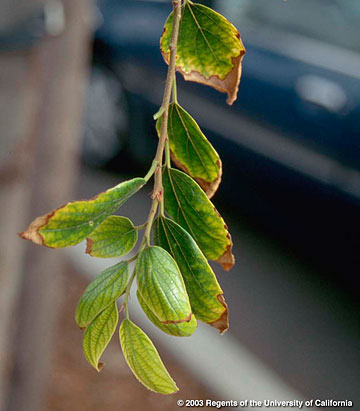
Photo courtesy of HortScience, Inc. |
Symptoms: Necrosis of tips and margins of older leaves on European hackberry; also, chlorosis of leaves. Diagnosis: Symptoms indicate tree is suffering from salt toxicity. Solutions: Leach salt from the soil by increasing the leaching fraction — the ratio of rootzone drainage to applied water. If other plants also exhibit symptoms of salt toxicity, the recycled water may need to be diluted by blending with less-saline water. |
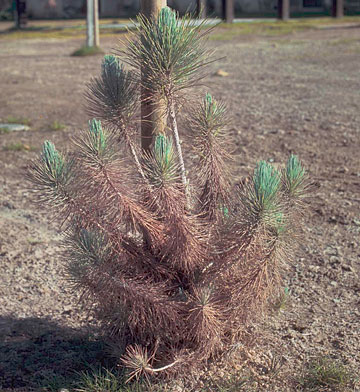
Photo courtesy of Hortscience, Inc. |
Symptoms: Older needles of this newly-planted conifer are necrotic. Diagnosis: Severe damages to the needles was caused by excessive salinity in the applied water. Solutions: Replace conifer with a species that is more salt-tolerant, such as Aleppo pine or Italian cypress. |
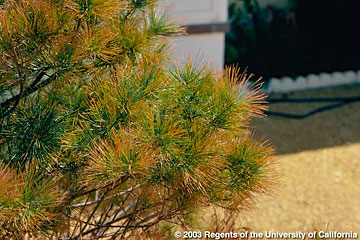
Photographer unknown; photo courtesy of Larry Costello. |
Symptoms: Tips of needles on this conifer exhibit reddish "burns." Diagnosis: This type of needle damage usually indicates that the plant is being sprayed by water that's more saline than the plant can tolerate. Solutions: Avoid wetting of conifer plant by sprinklers. If necessary, install bubble emitters for irrigation to avoid spraying. If those measures fail to suffice, replace this conifer with a species that is more salt-tolerant. |
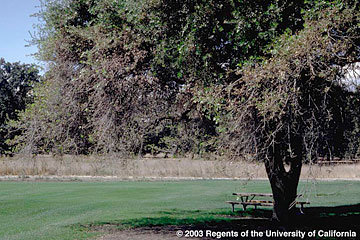
Photo courtesy of Perry. |
Symptoms: Necrosis and defoliation of lower branches of this coast live oak. Diagnosis: The necrosis and defoliation both are caused by wetting of the plant's leaves with saline irrigation water. Coast live oak is a relatively salt-tolerant tree. Solutions: Avoid foliar wetting of tree from sprinklers. This can be accomplished by changing sprinkler heads or replacing them with low-volume, low-trajectory sprinklers. Another possible remedy is to blend saline irrigation water with less saline water. |
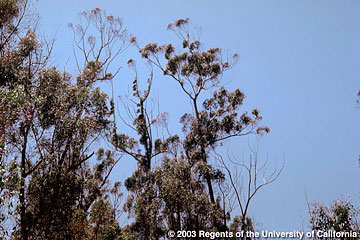
Photo courtesy of HortScience, Inc. |
Symptoms: Defoliation and necrosis of the top branches in sugar gum. Diagnosis: The stated symptoms are typical of salt damage. Soil analyses indicate high salinity at depth of 4 feet, but not at the soil surface or immediately below it. This is a soil problem, not a water salinity problem. Solutions: Leach salts from the soil by applying copious amounts of high-quality (low-salt or virtually no-salt) irrigation water. The goal is to move salts downward, beneath the root zone. |
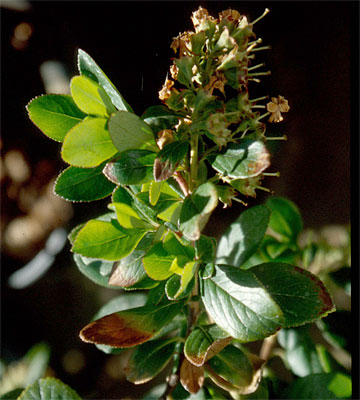
Photo courtesy of Lin Wu. |
Symptoms: Severe burns on growing tips of spray-irrigated Escallonia; minor injuries to other leaves, too. Diagnosis: The noted injuries result from irrigation with water of EC 2.1 dS/m, with 1,200 mg/L chloride and 800 mg/L sodium. Solutions: Escallonia is a salt-tolerant shrub. If damages persist or become more severe, dilute the irrigation water by blending it with less saline water. |
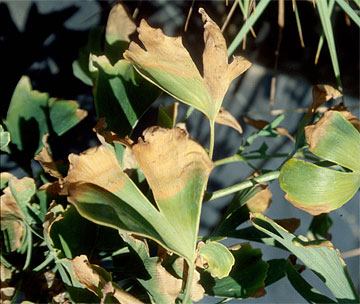
Photo courtesy of Lin Wu. |
Symptoms: Necrotic leaves on spray-irrigated Ginkgo biloba. Diagnosis: Ginkgo is a salt-sensitive tree. Damages noted are caused by irrigation with water of 0.9 dS/m, with 200 mg/L sodium and 400 mg/L chloride ions. Solutions: Avoid foliar wetting of this tree, or replace the tree with a species that's more salt-tolerant, such as Chinese tallow or silk oak. |
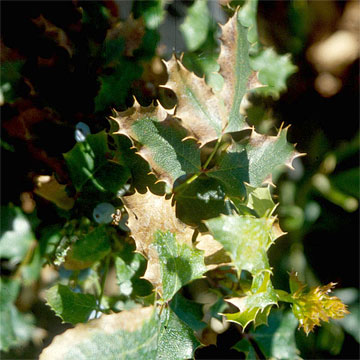
Photo courtesy of Lin Wu. |
Symptoms: Burned leaf margins on spray-irrigated California holly grape. Diagnosis: The salt damage noted is caused by irrigation with water of EC of 0.9 dS/m, with 200 mg/L sodium and 400 mg/L chloride ions. Solutions: Holly grape is a salt-sensitive shrub. Replace it with a more salt-tolerant species, such as wax myrtle or mock orange. |
| « Previous page | Next page » |